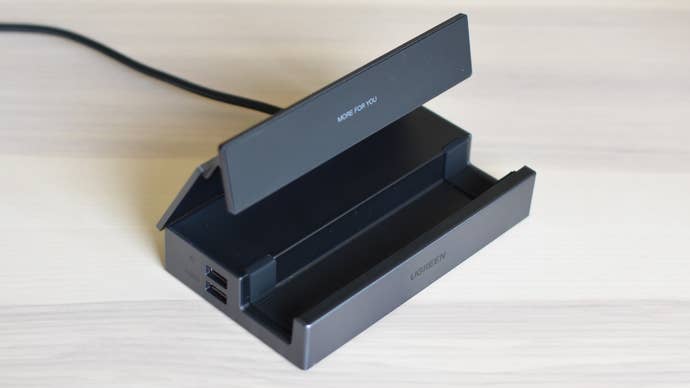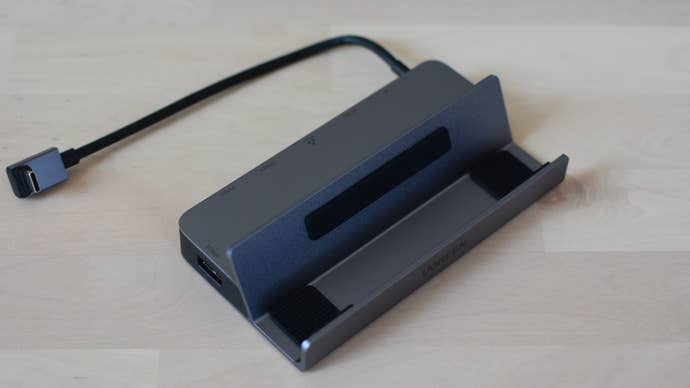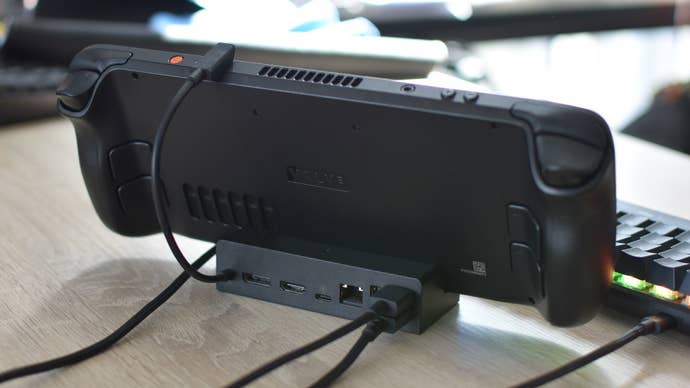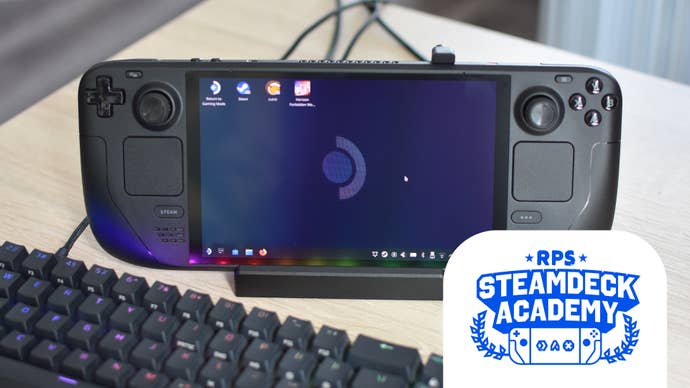The best Steam Deck docks
Give your Steam Deck some mouse 'n' keyboard comfort with the best docks we’ve tested
There’s a good chance you’re eyeing up this list of the best Steam Deck docks with suspicion and, frankly, I wouldn’t blame you. The Deck might be a PC in handheld form, but it’s arguably the best of its kind at adapting and optimising the desktop experience for portable controls and inputs. And, with other accessories like microSD cards and upgraded carry cases jostling to be top of the shopping list, the value of a docking station initially sounds lacking in comparison.
Except it shouldn’t, and it isn’t. I can scarcely imagine Steam Deck life without keeping a good dock handy, and that’s just because I’m nipping in and out Desktop Mode so often – to say nothing of how these can make your Deck a serious PC replacement or a cheap living room games machine. Consider starting with the models below, which are all my current favourites among the docks I’ve tested with both the Steam Deck and Steam Deck OLED.
 | Our Favourite Steam Deck DockThe Ugreen 9-in-1 Steam Deck Dock is our favourite dock for Valve's handheld. It's brimming with connectivity options and its adjustable stand makes for a comfortable and stable place to stash your Deck. It's surprisingly cheap, too. |
I heartily recommend a dock for both bigger-screen expansion and poking around Desktop Mode, itself a crucial component in getting the most out of Valve’s handheld. This is where you’ll be adding non-Steamgame launchers and other applications, massively expanding the device’s usefulness – and while navigating with the trackpads and on-screen keyboard is possible, it’s a thousand times easier with a connected mouse and keyboard. Take a leisurely scroll downwards to see which docks could best serve you; at the moment it's all third-party models, because while Valve do produce an official Steam Deck Docking Station, at £69 / $79 it's easily beaten on value.
Best Steam Deck docks
- Ugreen 9-in-1 Steam Deck Dock - the best Steam Deck dock overall
- Syntech Docking Station - the best unusual Steam Deck dock
- JSAUX 6-in-1 Multifunctional Docking Station - the most flexible Steam Deck dock
- Ugreen Docking Station for Steam Deck - the best budget Steam Deck dock
Ugreen 9-in-1 Steam Deck DockThe best Steam Deck dock overall |

There are only two reasons to pass on the Ugreen 9-in-1 Steam Deck Dock: one, the 6-in-1 version (below) is cheaper, and two, it’s slightly bulkier than most other docking stations. And the latter isn’t a very good reason. This is more adjustable, more stable, and more stuffed to the aluminium gills with connectivity than its rivals, all at a very agreeable price – especially next to the £69 official dock.
This is the first Steam Deck dock I’ve tested to provide both a pair of free USB-C ports and a trio of full-size USB slots, so it’s easily the best for regular Desktop Mode users who need to plug in extra peripherals. The same goes for its SD and microSD card slots – which again, most other docks seldom make room for – as well as the fully adjustable kickstand, which enables a wider choice of viewing angles. The raised contact pad that actually holds the Deck up is high enough to avoid blocking the rear vents, too.
This stand also joins forces with the grippy, deep-cut seating groove (chunkier handhelds like the Lenovo Legion Go fit too), the rubberized feet, and the relatively wide base to ensure the most stable of upright Steam Deck platforms. Honestly, who cares about a few extra square centimetres of footprint. This is an excellent docking station, and an absolute steal.
What we like:
✔️ Loads of ports and slots
✔️ Adjustable stand
✔️ Extremely stable
Syntech Docking StationThe best unusual Steam Deck dock |

The Syntech Docking Station is both pleasantly affordable and unusually quirky, adopting a rotund shape with a semicircular strip of well-spaced ports. It’s perfect if you’ve spent most of your Steam Deck accessory budget on a fat microSD card, but still want a dock that’s not a bargain bin bore.
Connectivity-wise, Syntech’s dock almost matches Valve’s own, including the healthy supply of three USB 3.0 (AKA 3.1 Gen 1) ports. It’s only missing a DisplayPort output, so any external monitor shenanigans will need HDMI. It also doesn’t grip the table as firmly as the official dock, but then stability isn’t really a concern, as the round base does mighty well at keeping the Steam Deck upright. Out of all the docks on this list, it’s the one I had the most trouble trying to knock over on purpose, so accidental bumps should give it even less bother.
What we like:
✔️ Stable base
✔️ Plenty of USB-A ports
✔️ Quirky design
JSAUX 6-in-1 Multifunctional Docking StationThe most flexible Steam Deck dock |

The (deep breath) JSAUX 6-in-1 Multifunctional Docking Station has perhaps the funkiest design on this list. The narrow backrest is in fact a removeable USB-C hub that, when it’s time to dock the Deck, slots into a simple plastic base, with the ports facing rearwards.
Its narrowness, and the lack of a locking mechanism, mean this isn’t as stable as a lot of fully integrated Steam Deck docking stations. But it is potentially more, ahem, multifunctional; if you’re taking your Deck on a trip and don’t forsee a need to keep it upright, then the detached hub is easier to take with you than a complete dock, while still being capable of serving up extra connectivity in a pinch. And that connectivity is basically a slightly higher-spec version of what you get on the Ugreen Docking Station, with dual USB-Cs (one with 100W power pass-through), two full-size USB slots, and an HDMI 2.1 port.
Adding to its flexibility, this dock also supports the Asus ROG Ally, and even the chunkier ROG Ally X and Lenovo's Legion Go. If anything, it’s even better suited to those than the Steam Deck, as the latter lacks the drivers necessary to take full advantage of the dock’s HDMI 2.1 output. Then again, considering the main games-specific benefit of HDMI 2.1 over 2.0 is higher refresh rates at 4K, it’s not a huge loss for a handheld designed to run much lower resolutions.
What we like:
✔️ Flexible hub
✔️ High-wattage power pass-through
✔️ HDMI 2.1 support
Ugreen Docking Station for Steam DeckThe best budget Steam Deck dock |

Besides being one of the cheaper Steam Deck docks, the Ugreen Docking Station for Steam Deck’s secret weapon is its second USB-C port. A literally tiny detail, sure, but consider this: most Steam Deck docks only have one, and it’s going to be filled in whenever you’ve got the power cable connected for pass-through charging. Any USB-C peripherals or external SSDs, of which there are a growing number, will thus lose their home – unless you have a dock like Ugreen’s to provide a spare.
While it apparently comes at the cost of a third USB-A port, two of those are still enough for a mouse and keyboard, and there’s more to like besides. Aluminium, as the main building materia, gives it a sleek look and rigidity that even Valve's official dock doesn’t quite achieve, and like Syntech’s dock, it can accommodate non-Steam Deck handhelds as well. It’s also got more grip than the circular Syntech, even if it’s not as topple-proof when the Steam Deck takes a clumsy bump.
What we like:
✔️ Sleek design
✔️ Extra USB-C
✔️ Low price
Steam Deck docks: setup and troubleshooting
Beyond a bit of cheeky firmware updating, Steam Deck docks don’t typically need much setup faff of their own. However, they are still mere blocks of circuitry and silicone, designed by fallible human hands, and as such may need certain encouragements from time to time. Hark, some tips...

Updating firmware
If you’re using the official Steam Deck Docking Station, you may be prompted to install Valve’s firmware updates on the Steam Deck itself. Otherwise, you can make sure your dock has its firmware up-to-date by following these steps:
- Connect the dock to your Steam Deck, with the power supply (that’s just your Deck’s own USB-C power cable) plugged into the dock.
- Restart your Steam Deck.
- Unplug both the dock from the Steam Deck, and the power cable from the dock.
- Wait 10 seconds, the connect everything again.
This should kickstart a firmware update, but if it doesn’t, try unplugging the power cable (while leaving the dock and the Deck connected).
Setting up displays
Besides the obvious stuff – making sure your monitor or TV has the correct input selected, for example – using your Steam Deck with an external display comes with some quirks.
- When connected with the Deck in Gaming Mode, its own screen will go black. That’s nothing to worry about, but if you want to keep the Steam Deck’s screen on, you’ll need to switch to Desktop Mode.
- The Steam Deck does not officially support passive cable adapters. They might work, but you’re more likely to see problems. Stick to active adapters (or just use the right cable) for the most reliable results.
- Likewise, try to make sure your cables meet the spec of your dock’s outputs. I once tried an HDMI 1.4 cable with the official dock’s HDMI 2.0 port, and it didn’t work – but after digging out a newer, HDMI 2.0-compliant cable, all was well.
- If the outputted video doesn’t fill your external display, you can attempt a fix using the Steam Deck itself. While in the default Gaming Mode, open the Steam menu, navigate to the Display menu, then disable "Automatically Scale User Interface." Finally, adjust the slider until the image fits the screen.
- When connected to a 1080p or 4K TV, you'll find that the Steam Deck's video output remains limited to 800p or 720p when playing in Gaming Mode. To run games at higher resolutions, you can switch to Desktop Mode and launch your games from there, after which you should have a much fuller list on in-game resolutions to choose from. Obviously, though, the Steam Deck's internals won't be able to run much at 4K, and even 1080p is beyond it for a lot of games.
Audio setup
While Steam Deck docks lack dedicated sound outputs – audio is purely carried over the HDMI or DisplayPort connections – you can enable 5.1 and 7.1 surround sound while docked. With your external display already connected and working, reboot your Steam Deck into Desktop Mode, and click on the speaker icon in the taskbar. Then, find the HDMI/DisplayPort slider, click on the three-line icon, and select the number of channels that your speakers support.


